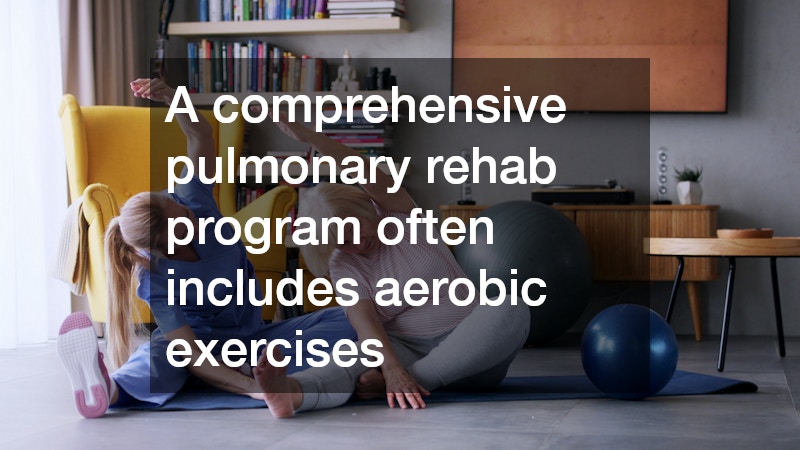Pulmonary rehabilitation is a comprehensive program designed to improve the physical and emotional well-being of patients with respiratory issues. Pulmonary rehabs allow individuals to regain control over their respiratory conditions, ultimately leading to enhanced lung strength and functional capacity. The program typically combines exercise training, education on the lung condition, and counseling to improve patients’ quality of life.
As awareness of chronic respiratory diseases rises, pulmonary rehabilitation has emerged as a cornerstone in managing conditions such as Chronic Obstructive Pulmonary Disease (COPD). By understanding the importance of this program, patients can make informed decisions about their treatment options and improve their respiratory health in a structured environment.
What is Pulmonary Rehabilitation?
Understanding the concept and components of pulmonary rehab programs is essential for recognizing how they aid respiratory health. Pulmonary rehabilitation refers to a multidisciplinary intervention that includes physical exercises, nutritional advice, and psychological support tailored for individuals with lung conditions.
Programs are often conducted in outpatient settings and may be run by a team of healthcare professionals, including doctors, nurses, respiratory therapists, dietitians, and exercise physiologists. Each participant receives a personalized plan that addresses their unique needs, medical history, and specific lung disease. This tailored approach ensures that patients are adequately supported throughout their rehabilitation journey.
The goal of pulmonary rehabilitation is not only to enhance lung fitness but also to empower patients with knowledge about their conditions. Education is a significant aspect, as patients learn about proper medication management, symptom recognition, and lifestyle modifications that play a crucial role in their overall well-being and lung function recovery.
How Does Pulmonary Rehab Improve Breathing?
Breathing techniques are integral, with practices like diaphragmatic and pursed-lip breathing often taught to patients. These strategies help slow down a person’s breathing rate, allowing for better oxygenation and carbon dioxide removal.
Additionally, exercise training greatly bolsters lung strength by improving endurance and muscle function. Activities that focus on aerobic capacity, strength training, and flexibility are carefully integrated into the program to ensure that patients build their physical capacity safely and effectively. This gradual increase in exercise levels directly leads to advancements in respiratory efficiency and overall health.
Moreover, pulmonary rehab fosters an environment for social interaction, which can significantly alleviate feelings of isolation commonly experienced by patients with chronic lung conditions. This formulation of support among participants often enhances motivation and adherence to exercise regimens, ultimately improving their breathing capabilities.
Who Can Benefit from Pulmonary Rehabilitation?
Identifying the patient populations that gain the most from pulmonary rehab is crucial for its implementation. Individuals diagnosed with chronic lung diseases such as COPD, asthma, pulmonary fibrosis, or cystic fibrosis are prime candidates for this rehabilitation program. These patients often experience debilitating symptoms that hinder daily activities, and pulmonary rehab provides tangible relief.
However, even patients with respiratory limitations due to conditions such as obesity or other chronic illnesses benefit from pulmonary rehabilitation. Patients with a reduced ability to participate in physical activity, regardless of the primary diagnosis, can experience improved lung function and quality of life through tailored exercise and education.
Additionally, those recently discharged from the hospital after an exacerbation of their lung disease often find significant advantages in participating in pulmonary rehabilitation. The transition from acute care to self-management can be daunting, but with the support provided in rehabilitation programs, patients can regain confidence in managing their conditions independently.
What Exercises are Typically Included in Pulmonary Rehab?
A comprehensive pulmonary rehab program often includes aerobic exercises such as walking, cycling, or jogging, which help improve cardiovascular health and increase lung capacity.
In addition to aerobic workouts, strength training is also incorporated. Resistance exercises enhance muscle strength and endurance, which is particularly important for activities of daily living. Attention to flexibility exercises like stretching is vital as well, facilitating greater mobility and ensuring that patients can engage in varied forms of physical activities effectively.
All exercises are tailored to the individual’s capability and are gradually increased in intensity. This personalized approach makes physical activity achievable and enjoyable, thus promoting long-term engagement and enhancing overall outcomes in lung function.
What Outcomes Can Be Expected from Pulmonary Rehabilitation?
Short-term outcomes typically include noticeable increases in exercise capacity, decreased breathlessness, and improved quality of life. Patients often report feeling more energetic and capable of engaging in daily activities.
Long-term benefits involve sustained improvements in lung function, reduced hospitalizations, and an overall decrease in the healthcare burden related to chronic lung disease management. Additionally, participants frequently acquire tools for self-management and symptom control, arming them with the knowledge necessary to cope with their conditions proactively.
Ultimately, the positive transformations resulting from pulmonary rehabilitation are not just physical. Participants experience psychological benefits, including improved mental health, reduced anxiety, and increased confidence in managing their lung health, contributing to a more fulfilled and active lifestyle.
As a structured program, pulmonary rehab offers comprehensive support that leads to significant enhancements in lung health and overall well-being. The collaborative nature of the rehab process fosters motivation and a sense of community among participants, further enriching the experience. It empowers individuals not only to regain their physical strength but also to make informed choices about their respiratory health.
Pulmonary rehabilitation stands as a pivotal element in the ongoing management of respiratory disease, proving that with the right support and tools, individuals can overcome the limitations imposed by lung conditions and enjoy a healthier, more active life.
